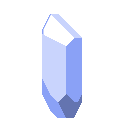Losing the game¶
Right now the game simply quits when we hit zero hit points, but that’s a bit unusual to say the
least. In this chapter we’re going to create a new GameState to represent our game over
screen.
Making a gamestate¶
Navigate to the modules/game/gamestates folder and create a new file called
gameoverstate.lua with the following contents:
--- @class GameOverState : GameState
--- @field display Display
--- @overload fun(display: Display): GameOverState
local GameOverState = spectrum.GameState:extend("GameOverState")
function GameOverState:__new(display)
self.display = display
end
function GameOverState:draw()
local midpoint = math.floor(self.display.height / 2)
self.display:clear()
self.display:print(
1, midpoint,
"Game over!",
nil, nil, nil,
"center", self.display.width
)
self.display:draw()
end
return GameOverState
We extend the GameState class and accept a Display in our constructor. For
now, we just draw “Game over!” centered on the screen by using Display:print()’s alignment
parameters.
Replacing the exit¶
Let’s head over to gamelevelstate.lua, and in the handleMessage function replace our current
handling of LoseMessage with the following.
if prism.messages.LoseMessage:is(message) then
self.manager:enter(spectrum.gamestates.GameOverState(self.display))
end
Let’s boot up the game and spawn in a few kobolds. Let yourself get slapped around and you should see our new game over screen when you die!
A couple keybinds¶
Our game state still forces you to close the game manually, so let’s add a couple keybinds to
restart or close the game. In controls.lua, add a couple entries:
restart = "r",
quit = "q",
Back in gameoverstate.lua, we’ll add a update callback to handle these. Don’t forget to
require our controls.
local controls = require "controls"
...
function GameOverState:draw()
...
end
function GameOverState:update(dt)
controls:update()
if controls.quit.pressed then
love.event.quit()
elseif controls.restart.pressed then
love.event.restart()
end
end
Note
See Input handling for a guide on input and controls.
Finally, let’s add some instructions.
self.display:print(
1, midpoint + 3,
"[r] to restart",
nil, nil, nil,
"center", self.display.width
)
self.display:print(
1, midpoint + 4,
"[q] to quit",
nil, nil, nil,
"center", self.display.width
)
self.display:draw()
Next up¶
We’ve improved our death handling by using a new GameState. In the next chapter we’ll be getting into map generation, and finally turn this into a real roguelike. The
following chapters will take you through generating a map and descending through the dungeon.
